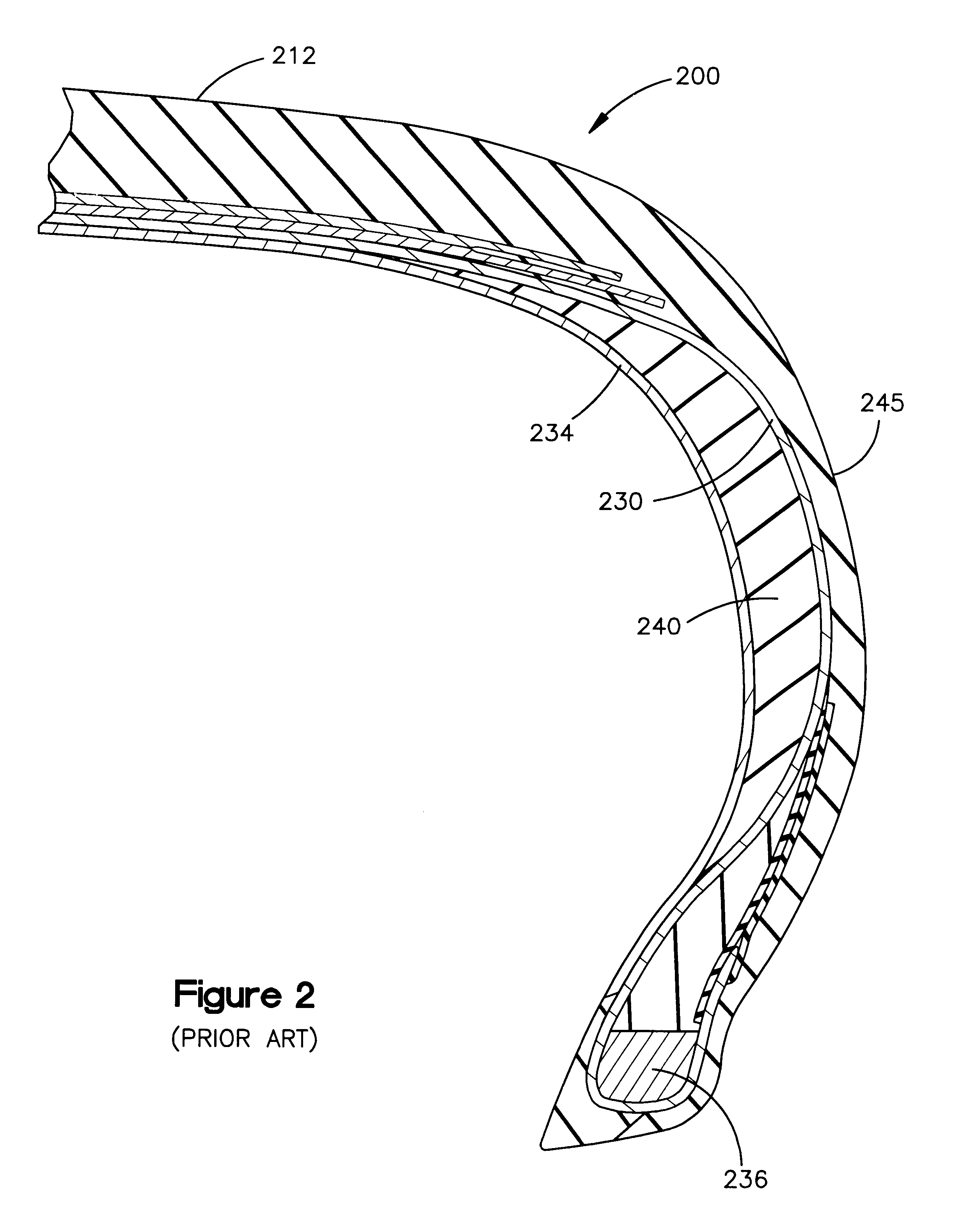Variable-stiffness wedge insert for runflat tire
a wedge insert and variable stiffness technology, which is applied to the sidewalls of tyres, vehicle components, transportation and packaging, etc., can solve the problems of reducing riding comfort, poor handling characteristics during normal inflated operation, and inability to achieve conventional inserts,
- Summary
- Abstract
- Description
- Claims
- Application Information
AI Technical Summary
Problems solved by technology
Method used
Image
Examples
second embodiment
FIG. 5A shows a schematic cross-section of a second embodiment of a circumferentially disposed insert 540 according to the present invention. The profile of insert 540 is shown in FIG. 5A as it would be in a normally inflated tire. The insert 540 is crescent-shaped in cross-section and comprises a somewhat semicircular elastomeric porous section 542 embedded in the axially-inner portion of the insert 540 surrounded by an elastomeric stiffer layer 544 (i.e. stiffer than the porous section 542) that comprises the remainder of the insert 540. The porous section 542 is attached to the stiffer layer 544 by any suitable means, such as cementing or overmolding one over the other. The substantially semicircular porous layer 542 is located at the vertically-center axially-inner portion of the insert 540, with its rounded edge facing axially outward. The insert 544 is bounded on its axially inner side by an innerliner 534 and on its axially outer side by a ply 530.
FIG. 5B shows the profile of...
third embodiment
FIG. 6A shows a fragmentary schematic cross-section of a third embodiment of a circumferentially disposed insert 640 according to the present invention. The profile of insert 640 is shown in FIG. 6A as it would be in a normally inflated tire. The insert 640 is crescent-shaped in cross-section and comprises a substantially triangular elastomeric porous section 642 embedded in the axially-inner portion of the insert 640 surrounded by an elastomeric stiffer layer 644 (i.e. stiffer than the porous section 642) that comprises the remainder of the insert 640. The porous section 642 is attached to the stiffer layer 644 by any suitable means, such as cementing or overmolding one over the other. The triangular porous layer 642 is located at the axially-inner portion of the insert 640, with one of its apexes pointing axially outward. The insert 644 is bounded on its axially-inner side by an innerliner 634 and on its axially-outer side by a ply 630.
FIG. 6B shows the profile of the insert 640 o...
fourth embodiment
FIG. 7A shows a fragmentary schematic cross-section of a fourth embodiment of a circumferentially disposed insert 740 according to the present invention. The profile of insert 740 is shown in FIG. 7A as it would be in a normally inflated tire. The insert 740 is crescent-shaped in cross-section and includes a cross-sectionally triangular elastomeric porous section 742 embedded in the radially-center axially-inner portion of the insert 740, affixed to a flexible inextensible hinge section ("hinge") 746 embedded in the axially-outer portion of the insert 740, and two stiff wedges 744A,744B (much stiffer than the porous section 742) that constitute the remainder of the insert 740. The porous section 742, the hinge section 746, and the stiff wedges 744A,744B are affixed together by a suitable means, such as overmolding each over the other(s). The insert 740 is bounded on its axially inner side by an innerliner 734 and on its axially outer side by a ply 730.
The triangular porous layer 742...
PUM
 Login to View More
Login to View More Abstract
Description
Claims
Application Information
 Login to View More
Login to View More - R&D
- Intellectual Property
- Life Sciences
- Materials
- Tech Scout
- Unparalleled Data Quality
- Higher Quality Content
- 60% Fewer Hallucinations
Browse by: Latest US Patents, China's latest patents, Technical Efficacy Thesaurus, Application Domain, Technology Topic, Popular Technical Reports.
© 2025 PatSnap. All rights reserved.Legal|Privacy policy|Modern Slavery Act Transparency Statement|Sitemap|About US| Contact US: help@patsnap.com



